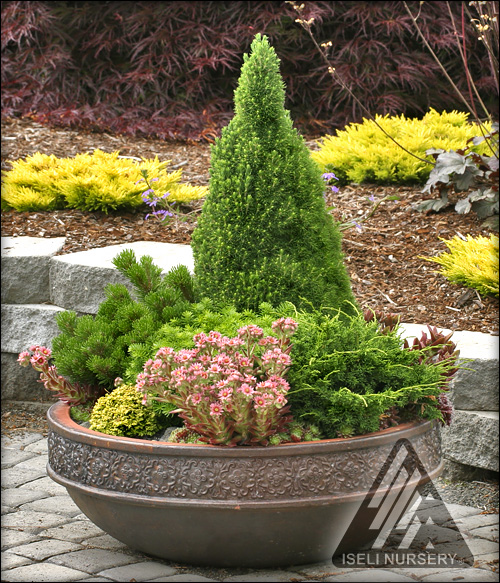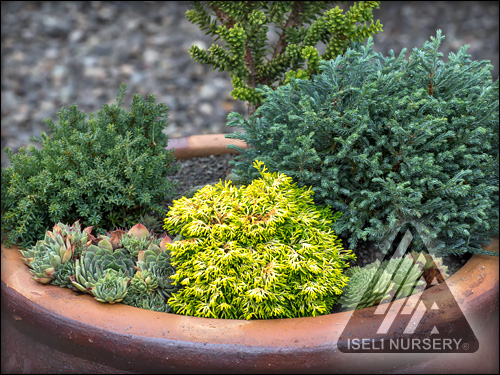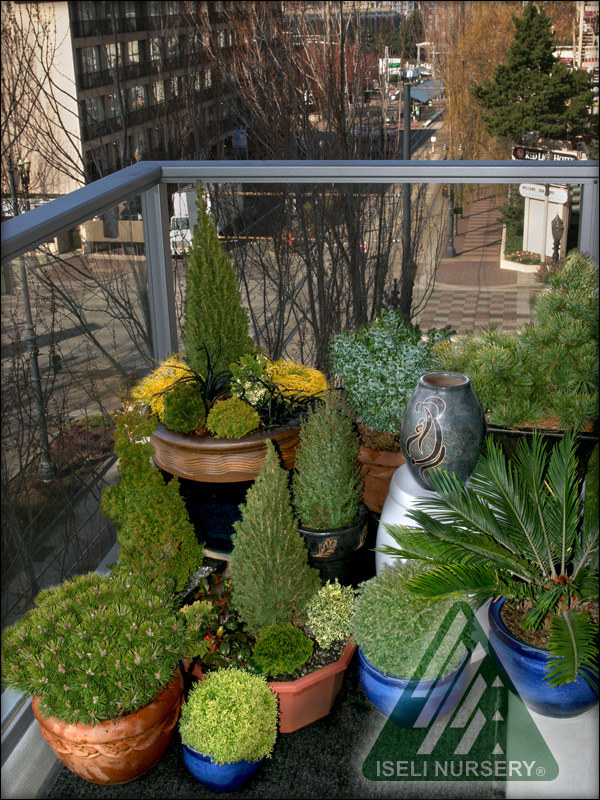Container gardening with small conifer trees allows you to enjoy the beauty of evergreens even in compact spaces. Dwarf spruces pines cypress, arborvitae, and more make excellent potted specimens for decks, patios, and porches. Let’s explore some top options for container-grown conifers!
Why Choose Small Conifers for Pots?
Miniature conifer trees offer many advantages as container plants:
-
Slow, compact growth – Many only expand 1-2 inches per year so can thrive for years before outgrowing a pot
-
Year-round interest – Evergreen foliage provides color and texture during the drab winter months.
-
Low maintenance – Require little pruning or water once established.
-
Mobility – Pots can easily be moved to adjust sun exposure as needed.
-
Versatility – Choices for nearly any design style, from formal uprights to cascading weepers.
-
Hardy constitution – Withstand wind, cold, and heat stress better than broadleaf evergreens.
10 Best Small Conifer Trees for Container Gardening
Here are some top mini conifer varieties perfect for pots:
1. Dwarf Alberta Spruce
This compact conical spruce has dense green needles and grows just 1-2 inches yearly. Easy to shape into topiary forms.
2. Dwarf Hinoki Cypress
Graceful fern-like foliage and irregular form make this one of the most popular mini conifers for containers.
3. Dwarf Blue Nest Spruce
Tight mounding habit with striking steel blue needles. Grows just 2 inches per year.
4. Green Mound Juniper
Soft powdery blue-green foliage and mounding habit work nicely in mixed pots.
5. Gold Thread Cypress
Finely textured golden thread-like foliage drapes attractively over pot edges.
6. Skyrocket Juniper
Narrow upright juniper perfect for formal accent or topiary. Bright green needles.
7. Teddy Bear Southern Yew
Cute mounding form with soft flat green needles fits smaller pots. Takes heat well.
8. Blue Star Juniper
Silvery blue needles organized in star-like sprays. Grows slowly to 1 foot tall and 3 feet wide.
9. Dwarf Japanese White Pine
Striking bonsai pine with layered branching and green needles. Slow upright grower.
10. Variegated Japanese False Cypress
Yellow-green and cream variegated foliage adds a pop of color. Gracefully weeping.
Design Tips for Conifers in Containers
Follow these tips to beautifully incorporate small conifers into potted arrangements:
-
Use conifers as focal points, accents, fillers, or spillers in container designs.
-
Mix finely textured and coarsely textured conifers for contrast.
-
Repeat the same cultivar for consistency.
-
Combine colored varieties like gold-tipped for added interest.
-
Pair low mounding species with taller upright ones.
-
Allow weepers and trailers to cascade over pot edges.
-
Underplant with low annuals, perennials, or groundcovers.
Caring for Container Conifers
Though low maintenance, container conifers do have some specific care needs:
-
Use a well-draining potting mix. Amend garden soil with compost.
-
Situate pots where conifers will get appropriate sun exposure.
-
Water 1-2 times weekly in summer, less in winter. Never let pots completely dry out.
-
Apply slow-release fertilizer in spring and summer.
-
Prune only to control size/shape as needed. Avoid heavy shearing.
-
Bring pots indoors or protect with burlap/plastic wraps in extreme cold.
With proper selection and care, potted conifers can thrive for many years, providing year-round evergreen beauty on patios, porches, and decks even in small spaces. Try adding one of these enchanting miniatures to your container garden!
Frequently Asked Questions About Small Conifer Trees in Pots
Here are answers to some common questions about growing container conifers:
What size pot do I need for a dwarf conifer?
Choose a pot 2-4 inches wider than the conifer’s nursery container. Miniature varieties can grow in pots as small as 10 inches wide.
How often do I water conifers in pots?
Water whenever the top 1-2 inches of soil becomes dry. Potted conifers need more frequent watering than in-ground ones.
Should I fertilize potted conifer trees?
Yes, apply a balanced slow-release fertilizer in early spring and a diluted liquid feed monthly during summer.
Do conifers in pots need winter protection?
In very cold climates, wrap pots or move to an unheated garage over winter. Keep soils moist during winter dormancy.
How often do I need to prune container conifers?
Minimal pruning is required—only to control size or shape. Never shear or cut back heavily. Simply pinch off unwanted new growth.
Can I bring potted conifers indoors for the winter?
It’s best to leave them outdoors as conifers need a period of winter dormancy. But an unheated garage works if they require extra protection.
With the right variety, design, and care, miniature conifers can beautify and brighten your patio or deck in any season!
Containing conifers for year-round pleasure

The summer flowers in our patio pots die off as the days get shorter as winter approaches. This leaves behind bare soil and unrealized potential. So what’s a gardener to do? Luckily, beautiful, dramatic conifers are a great choice for container gardens, with or without flowers that only last a short time. You can count on conifers to provide twelve full months of color.
Small conifers that grow slowly come in a huge range of cool colors, shapes, and textures, so gardeners can find the perfect plants to match any home style. Not only are conifers beautiful, but they are also naturally hardy and trouble-free, which makes them easy to grow. They need little care to maintain their elegant good looks. It’s cold hardy to USDA Zone 4, and most dwarf conifers grow so slowly that, with the right care, they can do well for years before they outgrow their spaces. Add seasonal flowers to change the scene during the year and to complement the structure of the conifers.
The popularity and availability of dwarf conifers has grown dramatically in recent years. Today, better garden centers sell small conifers with narrow spires and conical shapes that look great in containers. They come in colors like blue, green, yellow, and white. Gardeners can also pick dense, compact conifers that look like globes or buns. These come in a wide range of colors and textures. Some of them have soft, fluffy needles, others have strong, stiff needles, and still others have fern-like leaves that curve and twist, or fine needles that weep and drape. The options for dwarf conifers to fill containers are limited only by the imagination of the gardener.
The ABC’s of Dwarf Conifer Choices

AbiesTrue firs come in beautiful, adaptable garden forms with exceptional uniformity and regular branching. There are naturally low, prostrate shapes that spill over the edges of containers, small shapes that can be used in troughs, and weeping shapes that make great focal points. Stiff, pointed needles add deep colors and tight textures to garden scenes. Some of them also make brightly colored cones that stand upright as decorations.
ChamaecyparisChoices of the popular, diverse Chamaecyparis genus offer a wide range of color, texture, and shape. The False Hinoki Cypress, Chamaecyparis obtusa, can grow in full sun or partial shade and puts out sprays or fans of fine evergreen leaves that look great in pots. C. pisifera, the Threadbranch Cypress claims excellent cold hardiness and adds feathery foliage to the choices.
Juniperus: There is a juniper for almost every design need because they grow in a lot of different ways and have colorful leaves that change with the seasons. Most junipers are extremely cold hardy and resist pollution. Selections supply striking colors, superior habits and interesting shapes.
PiceaSpruces come in a range of sizes, shapes, and colors, such as blue, green, gray, gold, yellow, silver, white, mixed colors, and more. Some are very small, low, spreading domes; others offer an upright presence or a dramatically prostrate form. All spruces make striking statements and adapt to a wide range of climates.

As an ornamental conifer, pinus pines are some of the most beautiful. They come in a wide range of useful shapes and colors, and their evergreen texture gives containers character and style all year long. Undemanding pines are exceptionally adaptable and require little maintenance. They can develop superior drought tolerance, and once established, require little pruning or fertilizing. Columnar pines add height, but require only a narrow footprint in the design. Fine pyramidal forms provide vertical accent. Low, compact spreading and mounding pines become fabulous groundcovers, and pendulous or weeping trees provide high drama. Dwarf and miniature mugo pine cultivars come in tight, mounding, compact forms, with good adaptability and hardiness.
Tsuga Hemlocks are graceful, finely textured evergreen trees that come in many shapes and sizes, from small buns to bigger trees with wispy leaves that move around in the wind. Most Hemlocks are dark green, but several are available with bright golden yellow or white foliage. The elegant hemlocks like cool, moist northern climates, where they can be grown in sun or partial shade.
PETITTI | Growing Small Trees in Containers for the Patio
- The Ultimate Guide to Growing Strawberries in Raised Beds - August 8, 2025
- No-Dig Garden Beds: The Easiest Way to Grow a Beautiful Garden - August 6, 2025
- How to Protect and Preserve Wood for Raised Garden Beds - August 6, 2025

